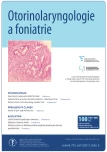Evaluation of speech in patients after cochlear implantation – Motol Speech Scale
Authors:
Z. Aksenovová
; M. Okluský
; J. Skřivan
Authors place of work:
Klinika ušní, nosní a krční 2. LF UK a FN v Motole, Praha
Published in the journal:
Otorinolaryngol Foniatr, 70, 2021, No. 3, pp. 156-160.
Category:
Původní práce
doi:
https://doi.org/10.48095/ccorl2021156
Summary
Introduction: The aim of this study was to create a new classification scale for the evaluation of speech in patients after cochlear implantation. Our newly created Motol Speech Scale (MSS) independently evaluates both speech components – perception and expression. Material and methods: We processed a set of 416 cochlear implant users. It was evaluated patients’ auditory perception level and speech status according to the internationally used Nottingham scale – Categories of Auditory Performation (CAP) and, at the same time, according to the Motol Speech Scale (MSS). The data obtained on both scales were compared and evaluated using the GraphPad statistical software. Results: The Spearman correlation test demonstrated the existence of a positive correlation between the CAP and MSS scales. Conclusion: Our newly created MSS scale is a suitable tool for classifying speech after cochlear implantation. It is understandable for CI users, parents, professionals, and the public.
Keywords:
cochlear implantation – speech perception – speech production – classification scale
Zdroje
1. Skřivan J, Bouček J, Tichý T. Kochleární implantace. Čas Lék Čes 2019; 158 (6): 228–230.
2. Skřivan J, Jurovčík M, Myška P et al. Historie a současnost kochleárních implantací v Česku. Čes-slov Pediat 2018; 73 (7): 424–426.
3. Vymlátilová E, Příhodová J, Šupáček I. Faktory ovlivňující využití kochleárních implnatátů u dětí. Otorinolaryngol Foniatr 1999; 48 (3): 131–134.
4. Coninx F, Weichbold V, Tsiakpini L. LittlEARS Auditory Questinonnaire. Innsbruck: Austria MED-EL 2003.
5. El-Adawy AN, Emam AM, Mostafa EM et al. Assessment protocol for auditory and language abilities in cochlear implanted children used in Sohag university hospital. Egypt J Neck Surg Otorhinolaryngol 2020; 6 (1): 17–36. Doi: 10.21608/ejnso.2020.70557.
6. Esser-Leyding B, Anderson I. EARS (R) (Evaluation of Auditory Responses to Speech): an internationally validated assessment tool for children provided with cochlear implants. ORL J Otorhinolaryngol Relat Spec 2012; 74 (1): 42–51. Doi: 10.1159/000335054.
7. Robbins AM, Renshaw JJ, Berry SW. Evaluating meaningful auditory integration in profoundly hearing-impaired children. Am J Otol 1991; 12 Suppl: 144–150.
8. Weichbold V, Anderson I, D‘Haese P. Validation of three adaptations of the Meaningful Auditory Integration Scale (MAIS) to German, English and Polish. Int J Audiol 2004; 43 (3): 156–161. Doi: 10.1080/14992020400050021.
9. Zimmerman-Phillips S, Robbins AM, Osberger MJ. Infant-Toddler Meaningful Auditory Integration Scale. Sylmar, California: Advanced Bionics Corp 2001.
10. Archbold S, Lutman ME, Marshall DH. Categories of auditory performance. Ann Otol Rhinol Laryngol Suppl 1995; 166: 312–314.
11. Archbold S, Lutman ME, Nikolopoulos T. Categories of auditory performance: inter-user reliability. Br J Audiol 1998; 32 (1): 7–12. Doi: 10.3109/03005364000000045.
12. Nikolopoulos TP, Archbold SM, Gregory S. Young deaf children with hearing aids or cochlear implants: early assessment package for monitoring progress. Int J Pediatr Otorhinolaryngol 2005; 69 (2): 175–186. Doi: 10.1016/j.ijporl.2004.08.016.
13. Vymlátilová E, Kabelka Z, Šupáček I et al. Program kochleárních implantací u dětí: rozšíření diagnostických možností a hodnocení faktorů ovlivňujících přínos implantace. Závěrečná zpráva o řešení grantu Interní grantové agentury MZ ČR. Praha: IGA MZ ČR; 2005.
14. Allen MC, Nikolopoulos TP, O‘Donoghue GM. Speech intelligibility in children after cochlear implantation. Am J Otol 1998; 19 (6): 742–746.
15. Aksenovová Z. Kochleární implantace u dětí s vícečetným postižením. Pediatr Praxi 2009; 10 (4): 266–268.
16. Aksenovová Z, Kabelka Z. Výsledky kochleárních implantací u hluchoslepých dětí. Otorinolaryngol Foniatr 2010; 59 (2): 51–54.
17. Dlouhá O. Klasifikace vývojových poruch řeči. Otorinolaryngol Foniatr 2005; 54 (1): 27–31.
18. Dvořák J. Logopedický slovník, 3. vyd. Ždár nad Sázavou: Logopedické centrum 2008.
19. Černý L, Skřivan J. Kochleární a kmenová implantace u dospělých – výsledky. Otorinolaryngol Foniatr 2007; 56 (4): 191–194.
20. Gál B, Kostřica R, Hložek J et al. Brněnské implantační centrum: výsledky léčby jednostranné kochleární implantace u dospělých pacientů. Otorinolaryngol Foniatr 2019; 68 (1): 18–23.
21. Vokřál J, Černý L, Skřivan J. Nastavování zvukových procesorů u pacientů s kochleárním implantátem na Foniatrické klinice 1. LF UK a VFN. Otorinolaryngol Foniatr 2012; 61 (4): 216–222.
Štítky
Audiologie a foniatrie Dětská otorinolaryngologie OtorinolaryngologieČlánek vyšel v časopise
Otorinolaryngologie a foniatrie

2021 Číslo 3
- Podávání probiotik s obsahem L. reuteri Pharax jako adjuvans k léčbě faryngitidy a tonzility u malých dětí
- Isoprinosin je bezpečný a účinný v léčbě pacientů s akutní respirační virovou infekcí
- Nosní sprej s kombinací antihistaminika a kortikosteroidu uleví alergikům nejrychleji
- Pacienti s infekcemi HPV a EBV a možnosti léčebné intervence pomocí inosin pranobexu
- Doc. Jiří Kubeš: Zásadní přínos protonové terapie spočívá v ochraně zdravých tkání
Nejčtenější v tomto čísle
- Akutní závrať v pohotovostní službě ORL lékaře
- Vrozené vývojové vady vnitřního ucha
- Sklerotizace krčních cyst alkoholem pod ultrasonografickou kontrolou jako alternativa operačního řešení
- Hodnocení řeči u pacientů po kochleární implantaci – Motol Speech Scale

